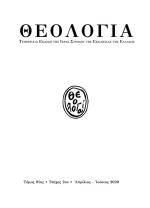Citation:
Καρακόλης, Χρήστος. “Οἱ περὶ Ἰουδαίων ἀπόψεις τοῦ ἱεροῦ Φωτίου”. Θεολογία 91, no. 2 (2020): 7-31. Copy at http://www.tinyurl.com/26zyc4nc
| 64733542.pdf | 225 KB |

Abstract:
The time of Photios the Great was crucial for the Jewish-Christian relations. The Byzantine Empire exited the iconoclastic controversy in 842 AD, for which the Jews had been partly held responsible. In 861 AD, the Byzantines attempted to approach the Khazars, who had largely embraced Judaism. Furthermore, starting in 872, emperor Basil I made a series of attempts to convert the Byzantine Jews to Christianity.This historical background is reflected by the numerous references to the Jews in Photios’s works. Photios generally utilizes acute anti-Jewish rhetoric, through which he seems to be seeking to construct a unified Christian identity following the iconoclastic divide. It is noteworthy, however, that Photios focuses his anti-Jewish rhetoric on the events of the New Testament, while he avoids referring to the Jews of his time and thereby inciting tension towards them. He also makes positive remarks about Jewish believers and states his faith in the eschatological conversion of all Jews to Christianity. While Photios addresses his sermons and writings to an exclusively Christian audience, the discourse of modern-day Church is de facto addressed to humanity as a whole. Therefore, our Church should rather adopt a rhetoric of reconciliation, promote a sincere theological discourse, and transcend all sorts of stereotypes. The theological dialogue between the Byzantines and the Khazars, inspired by Photios the Great, is a valuable precedent in this endeavor.

